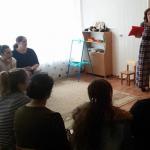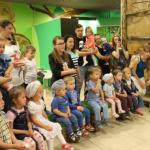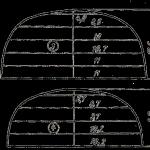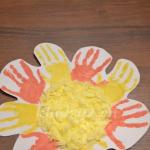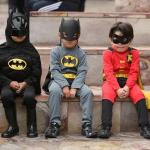Games with water for children. Water games for little ones Water games for kids 2 x
Water is a fascinating environment for a child. She calms and develops the baby
- Since water has different temperatures, sometimes cold, sometimes hot, if you tint it, it takes on different colors and shades
- In addition, water can so interestingly overflow over the edge of the dish and spread across the floor or suddenly disappear, being absorbed into the sponge. All this is so interesting for the baby.
Do not forbid your child to play, because such games with water well develop accuracy, attention, observation, and eye.
To play with water, all you need is a small container and tap water.
From cup to cup with a teaspoon
Take two plastic cups, a tablespoon and a teaspoon. Take warm water and pour it into one of the cups. We show the baby how to play with water, pouring it with a spoon from one cup to another. And give the child the opportunity to play by himself, pouring water with a tablespoon or a teaspoon.
- This seemingly simple activity perfectly develops fine motor skills. And at the same time, the baby learns such concepts as “empty - full.”
Pour and pour
To play with water, you need a small container (a bucket or basin) with some water and two cups (large and small). We put a bucket of water on the floor and show how to play: scoop water from the bucket with a small cup, and then pour it into a large one. While playing, the child learns the properties of substances and develops coordination of movements.
Sponge
Prepare a foam sponge and two containers. Fill one of the containers with water. Show your child how to use a sponge and how to use it to pour water from one container to another. Allow your child to do this himself. The game develops fine motor skills well.
Ships
Take small pieces of paper and a basin. Pour water into a basin and throw pieces of paper into it together with your baby. Then blow on them and invite your child to do the same. Such games with water contribute to the development of the articulatory apparatus and fine motor skills.
Sieve
For this activity, prepare a container of water, a cup and a sieve. The baby needs to take water into a cup and pour it into a sieve. Tell your child clearly why water flows through the sieve. While playing, the baby learns the properties of substances and the purpose of objects.
Floats, drowns
Collect various small items such as pebbles, buttons, beads, shells, small toys, scraps of fabric and let the child take turns throwing them into the water and observing. Some objects will remain on the surface, others will immediately sink. Try to explain in an accessible form why this happens. This activity is useful for the baby, because this is how the properties of objects are learned and the basics of classification are mastered.
Bouncing ball
You will need: a plastic table tennis ball. Turn on the water tap and throw the ball into the stream of water. It will be interesting for the child to watch the ball jumping in the stream without jumping out of it.
Rain
Take a small baby watering can plastic toys and a basin or bowl of water. Invite your child to give the dolls a “shower.” Let the child fill the watering can with water and water the toys. Pay attention to the crumbs how the water flows from the watering can, that its streams look like rain. Read poems about rain. And after the “toy bath”, give the child a small towel and show how to properly dry the toys. When the baby masters such actions well, you can move on to watering the flowers.
Watering the flowers
- You have a small children's watering can, show your child how to water the flowers growing on the windowsill at home. Tell your child that in order for plants to grow and bloom beautifully, they need to be looked after: fertilized and watered. Together with your baby, look at the droplets of water that remain on the leaves of the plant.
- Dear parents, if you found the article Water games for children helpful early age, share with your friends, click on the buttons below, perhaps someone is now looking for the same information on the Internet. Thank you!
You will need: 2 glasses, a teaspoon, a tablespoon.
Pour water into one glass. Show your child how to use spoons to pour water into another glass. Let him play on his own.
The game promotes the development of fine motor skills and helps to master the concepts of “empty - full.”
Poured and poured
You will need: a container of water, 1 large glass and 1 small glass.
Place a bowl of water in front of your child and show how you can scoop up water with one glass and pour it into another. Give your child freedom of action.
The game promotes the development of coordination of movements, expands ideas about the properties of matter
- Wring out the washcloth
You will need: two containers, a foam sponge. Fill one container with water. Show your child how you can use a sponge to transfer water from one dish to another. Offer to try to do the same thing yourself.
The game develops fine motor skills.
- Ships
You will need: basin, paper.
Pour some water into the bowl. Show your child how to throw small pieces of paper into a basin and blow on them. Most likely, the child will repeat your actions.
The game promotes the development of fine motor skills and the articulatory apparatus.
Through the sieve
You will need: glass, sieve.
Place a bowl of water in front of the child and let the child pour water from the glass into the sieve. Explain to him why the water flows away.
In the game, the child learns the purpose of objects and the properties of matter.
- Will it float or sink?
Place a bowl of water in front of the child, give him buttons, pebbles, scraps of fabric, small toys, a metal and wooden spoon. Let your child throw all the objects into the water and watch them. Explain why some things sink while others remain on the surface.
In the game, the properties of objects are learned, the foundations of classification are laid, and fine motor skills are developed.
- Watering the flowers
You will need: a baby watering can.
Take a watering can with water for a walk. Find a flowerbed and explain to your child that in order for the flowers to grow well, they need to be watered. Let the baby water the flowerbed himself. Draw his attention to how the earth darkens during rainfall. You can water the grass, trees, shrubs, while telling how the plants drink water. Look at the droplets of water remaining on the leaves, notice that the streams of water from the watering can look like rain. Sing a song or read a poem.
Let's take a watering can
And we’ll pour water into it.
We will water the flowers with a watering can,
Grow up quickly!
The game promotes the development of imagination and motor skills. The child studies the properties and purpose of objects and gets acquainted with the plant world.
Rain
You will need: watering can.
Place plastic toys in a basin or bathtub, give the child a watering can and offer to play with the doll's rain. Water the dolls with a watering can, remembering all the poems you know about rain. After the “rain”, give your baby a dry towel and ask him to dry all the toys.
Rain, rain!
Leisure more!
Let it grow
The wheat is thicker!
Leisya, Leisya,
Like a river!
There will be white flour!
G. Lagzdyn
Rain, rain, drop.
Water sabre.
I cut a puddle, I cut a puddle,
Cut, cut, didn't cut,
And tired
And he stopped.
The game promotes speech development.
- My chimney sweep
You will need: a small plastic or rubber doll, a foam sponge. Ask your child to wash the dirty doll. Name the parts of the body that need to be washed: “Now wash her leg, look how dirty she is,” etc. You can soap the sponge, draw the child’s attention to how the soaped doll slides in his hands.
The game promotes the development of motor skills and speech.
- Bouncing ball
You will need: a plastic table tennis ball.
Turn on the water tap and throw the ball into the stream of water. It will be interesting for the child to watch the ball jumping in the stream without jumping out of it.
Funny poems
While soaping your baby, read him funny rhymes and nursery rhymes:
X squelch-squish hands,
The basin is full of soap.
Don't touch, Mashenka,
Soap pen eyes.
And the water gurgles,
And the water is foaming,
Mashenka will wash herself,
He combs his hair and gets dressed.
The game promotes speech development and strengthens trusting relationships.
Let's wash ourselves
When washing your baby, read a funny poem, accompanying him with appropriate actions:
Neat bunnies
Paws?
Washed.
Ears?
Washed.
Tail?
Washed.
Everything was washed.
And now we're clean
Fluffy bunnies.
During the game, the child remembers the names of body parts.
Prepared by Svetlana Dmitrievna Shadrunova, teacher of MBDOU No. 54 “Iskorka”, Naberezhnye Chelny
Studying the properties of water
All children are very attracted to playing with water.
If your baby is fussy, try to distract him by putting him in a bathtub full of water and giving him empty shampoo jars and bottles. plastic cups, sponges and small terry towels. Very soon the child’s mood will change - he will be busy with an interesting game.
The baby will begin to pour water, watch how
containers filled with water sink and empty ones float up from the bottom.
In summer, on a warm sunny day, you can organize games with water in the fresh air,
pouring it into a basin or inflatable pool. If you and your child spend time on the shore of a pond, the games will become even more varied and exciting. During the experiments and games, the young experimenter will probably have a lot of questions that you will certainly have to answer.
So, the child begins to get acquainted with the properties of water. To do this, provide him with everything
Prepare a watering can, funnel, and transparent containers different shapes and sizes, measuring cup. First of all, draw the child’s attention to the fact that the water is clear. Give your child a small toy or pebble and ask him to hide it in his fist. Then ask: “Where is the toy? No, she is not visible. Now let’s hide the toy in the water, put it in the basin.” Having completed the task, the child makes sure that the toy lying on the bottom is visible. Explain to your child that the water is transparent, so everything is visible in it. If you have an aquarium, look at the pebbles, fish and plants in it with your child. Ask your child why they are so visible.
Show your child one more property of water: water has no taste. To prove it, pour boiled water into three cups.
water: put a teaspoon of sugar in one cup
ra, add salt to the other, and leave the third untouched
chickpeas Invite your child to taste the water from all the cups.
You can make sure that the water has no odor by sniffing different liquids, for example, shampoo, fruit juice, aqueous solution of Vale-
riana and comparing their smell to the "smell" clean water.
Show your child that water is pouring and
takes the shape of the vessel into which it is poured. To play, give the young explorer a watering can filled with water and several transparent jars of different shapes. By pouring water into them, the child will see for himself the ability of water to fill vessels of any shape.
Invite your child to check the saying “Water will find a hole.” For the experiment, offer a plastic bottle, in the lower part of which several holes of different sizes are made. Moreover, the wider the hole, the thicker the stream of water flowing from the bottle will be.
To measure the volume of bottles of different shapes, offer your child a measuring cup and a funnel. Inserting a funnel into the neck of the bottle, show your child how to carefully pour water from a measuring cup into it. Do not forget to count out loud the number of glasses that are poured into
measured capacity. By doing the same with a bottle of a different shape, the child will find out which of them contains more water, and together with you he will be able to draw a conclusion about which of the two bottles is larger.
You can also spend it with your child
one interesting experiment, immersing in water
items made from different materials, and watching which ones sink and which ones don't. Draw the child's attention to the fact that wooden and hollow toys, which contain air inside, float on the surface of the water, and metal objects sink.
The following experiment will prove that air is lighter than water and therefore always tends to escape from the water. Take an empty transparent plastic bottle and carefully open the neck
lower it down into the water. Then bend the bottle under water so that air bubbles run up from it. Surely the child will want to repeat this experience himself.
Introduce your child to the properties of water as a solvent. To do this, give your child several transparent cups of water and paint, watercolor or gouache. He will be interested in getting different shades of the same color by adding more paint to one glass and less to another. You can create three shades by adding just a little paint to the water. And if you try really hard, there will be even more shades. Coloring water will help your child understand the patterns of color mixing. Combination
red and yellow paint gives orange water,
yellow and blue - green, blue and red - violet.
When the young artist finishes his experiments in coloring water, put it in the freezer. And the next day, show your child the colored pieces of ice and watch together how they melt. In this way, the child learns about another property of water - its ability to turn into ice in the cold.
In order to demonstrate to the child the ability of water to turn into steam
(evaporate), watch with your child
over boiling water. And then conduct an experiment: cover a container with boiled water and watch how the condensed steam again turns into drops of water and flows down.
Pour some water into a saucer and leave it for a few days. Eventually the water will evaporate and the saucer will become empty.
While walking with your child, observe
behind the puddle. The surrounding objects are reflected in the water
you, but they instantly disappear if you throw something into a puddle. Puddles come in different sizes
ranks and depths: large and small, deep and shallow - some need to be bypassed, while others can simply be stepped over. The depth of the puddle
can be measured with a stick or spatula.
Demonstrate to your child the life-giving properties of water. To do this, place the branches of a bush or tree in the water; after a while, leaves will appear on them. If it’s summer or autumn outside, you can put a flower in water and leave another one without water - let the child see for himself which one withers first.
That's how many interesting observations can be made by studying the properties of ordinary water itself.
Useful and funny
water games
This chapter describes games that
You can play both at home and outside in hot weather. The main thing that unites them is that by playing them, the child gains new knowledge and useful skills. Some of these games can be played as fun competitions or competitions. And not only children, but also their parents can participate in these competitions.
Bathing toys
Invite your child to bathe his toys himself.
Rushki in a bowl of warm water. Give him everything he needs for this: a basin, soap, a brush, a sponge.
and a towel. If you add foaming detergent to the water, then this is an activity for re-
your baby will become more attractive.
We do the laundry - we help mom.
When you get ready to do the laundry, involve your child in this useful task, providing him with everything necessary for this. Let him wash the handkerchiefs or doll's dress in a small basin next to you, and then, after wrung out, hang them to dry. Along the way, you can ask your little helper riddles or read poems.
It slips away like something alive, but I won’t let it go.
It foams with white foam and is not too lazy to wash or wash.
(soap)
Let's do the laundry now, we need soap, we need...
(pelvis)
I am my mother’s only son, my mother has no daughter.
How can you not help your mother wash the handkerchiefs?
The soap foams in the washtub, I wash it, look.
The diligent daughters washed all the handkerchiefs.
And then they pet it themselves - they know how to help mom.
Fishing
Buy a game in the store in which plastic fish with a metal center are caught with a magnetic fishing rod. If you were unable to buy the game, you can make it yourself by cutting out fish from thin plastic and attaching a metal paper clip to each of them. It’s also not difficult to make a fishing rod, you just need a magnet.
Place the finished fish into a basin or transparent jar of water. Let the child
catches them with a fishing rod, saying: “Catch them, fish, big and small!” During the game, explain to your child why fish are attracted to the magnetic fishing rod. And you can remove the paperclip from a homemade fishing rod and demonstrate to your child that the fish has stopped being “caught.”
Level
(game for older children preschool age)
Tell your child that builders in their work use one of the simplest and most convenient devices called a level. With its help, workers determine whether the floor in the house is level and whether there is a slope in any direction. You can make this device yourself. For this you will need
a transparent tube with a diameter of 1.5 to 4 cm and a length of 10-18 cm, sealed or tightly sealed with a stopper at one end. It is necessary to fill it with water almost to the very edge, and then securely plug it with a stopper. It is important that one remains near the surface
air bubble. When you place the “level” on a horizontal surface, the air bubble will begin to move and then stop exactly in the middle of the tube. If the surface is inclined, the bubble will run away from the center to the edge. Ask your child to check whether the table in your house is level and whether there is, even a slight, slope at the floor or window sill.
Sinking ship
Place a soap dish, bowl or unbreakable bowl on the surface of the water in a basin or bathtub.
plate. Then show your child how to pour water into it in a thin stream from a watering can or other container with a spout, waiting for the moment when the water level in the floating container reaches a critical level and it begins to tilt and sink. Invite the young tester to conduct this experiment himself.
You can organize this game for 2 children, introducing a competitive element into it. Let
children pour water into identical containers in very thin streams so that the “ships” remain on the surface longer. Wins
in this competition, the one whose ship will sink last. Ask your child why the ship first floated and then sank.
Long voyage
Do it with your child paper boat(how to do this is shown in the figure), and then lower it into the water in a basin or bathtub. Show your child how to blow on it so that the boat begins to move, moving away from you. The stronger and longer the air stream you blow, the longer the boat will float. Compete with your child to see whose boat will sail farther. Ask your child what, in his opinion, determines the distance of the boat.
Playing with water on a hot summer day
In these funny Games you can play while relaxing on a hot sunny day at the dacha or sunbathing on the beach, when it’s not scary to be wet from head to toe, but on the contrary, it’s nice to splash water on each other.
Accurate shooter
For this competition, you need to place bottles on the table or bench according to the number of players. Place a light plastic ball (for playing table tennis) on the neck of each bottle. Make a sprinkler for each child. It can be made from any plastic bottle, piercing a hole with a diameter of 3-5 mm in the lid. The sprinklers are filled with water. Now everything is ready for the competition in accuracy.
Participants in the game stand at a certain distance (marked by a line) and, using a water jet from a spray bottle, try to knock the balls off the bottle. The one who succeeds first wins.
Wet fight
Two or more children, armed with splashing
kami, trying to pour water on each other. The participants in the game take turns dodging
from the stream, then, on the contrary, they go on the attack on the enemy, trying to spray him with water. Truce comes only when the spray
The jackdaws are running out of water. The winner in this game is the one who managed to wet the opponent the most.
Splatter tags
The game is reminiscent of traditional tag, differing from them only in that the driver does not stain the players with his hand, but tries to spray them with a stream of water. The one whom he managed to pour water on becomes the driver and receives a sprinkler. And the driver turns into a player.
Scoop up the water
For this game, give two players identical basins or buckets of water and mugs of the same volume. Players compete to see who can quickly scoop water out of a bucket using a mug, pour it into a basin without spilling the water.
Water carriers
Each player is given a glass filled to the brim with water. Children run at the leader's signal
to the finish line and return back to the start line. The player who comes first and does not splash the water wins.
Natalia Chernikova
The first substance that a child gets acquainted with with pleasure is water. Playing with water is one of the most nice ways training.
Playing with water creates a joyful mood in children and increases vitality, give children a lot of pleasant and useful impressions, experiences and knowledge. This is especially important for the youngest children.
By organizing children's games with water, we solve the following problems:
1. We contribute physical development child (we develop fine motor skills, visual and motor coordination).
2. We introduce the child to the world around him, including the properties of water.
3. We expand and enrich our vocabulary.
4. Relieve psychological tension and aggression.
Description of the educational game
"Let's catch the balls out of the water"
Goals: teach children to hold a strainer right hand, develop fine motor skills, accuracy, dexterity.
Facilities: 2 basins, one of which with water, a strainer with a handle, a set of wooden and plastic balls, aprons.
We hold the sieve tightly,
We catch the balls from the water.
Description of the educational game.
“There was a puddle - and it’s not there”
Target: develop interest in playing with water.
Facilities: sponges, tray, basin of water, apron.
Guidelines: The teacher shows the children how a sponge can absorb water. Invites children to dip a sponge into a bowl of water. And then squeeze the water onto a tray. Perform this exercise until your pelvis becomes dry.
Then, on the contrary, the teacher gives the children the task of removing the puddle of water from the tray using sponges.
After playing with water there was a puddle left,
You and I need an assistant.
Let's take a sponge and get wet,
We'll quickly clean up the puddle.

We are not too lazy to clean up,
We can do this every day.
“When you play, take it away!
That’s the game’s motto!”

We blow soap bubbles
And that means we’re playing with some water.
And also, we’ll blow bubbles,
We will develop breathing.

We'll go fishing
We'll take the fishing rod with us.
Fish, fish, get caught,
The child always plays with water with great pleasure. But this is not only a gaming activity, but also one of the most enjoyable ways of learning. Activities with water lift children's spirits and give them a huge amount of positive emotions. It is especially important to organize games with water for children 2-3 years old in kindergarten. A child at this age learns and learns better the world tactile and emotional.
What are the benefits of playing with water for babies?
When organizing classes with water in kindergarten, the teacher pursues the following tasks:
- Physical development of the child, visual coordination;
- Introducing children to features environment, V game form We study the properties of water, tell the children that water is wet. We develop cognitive activity. For example, we explain to kids why their hands are visible through the water;
- The vocabulary is enriched;
- Water helps relieve tension and negative emotions;
- We support children’s interest in playing together, teach communication in a team;
Basic games with water for children 2-3 years old in kindergarten
For organization play activity prepare with water foam sponges, watering cans, plastic cups, lids, cups, two basins, aprons, towels.
- Game "Catch the ball". Small plastic balls are placed in a bowl of water. The child is given a strainer with a handle and asked to catch the balls from the water. Prepare a second empty bowl in which the children will put the caught balls. This game develops fine motor skills, accuracy, dexterity;
- Game "Puddle". For this activity you will need a sponge, two basins, one with water, the other empty. The teacher invites the children to dip a sponge into a bowl of water and then squeeze it into an empty bowl. You need to carry out actions until the water in the basin runs out. You can present this game as if the children cleaned up the puddle on their own. Choose a poem about a puddle, you can read it to the kids during the activity;

- Playing with water can be combined with a theatrical fairy tale about a chicken. A chicken comes to the kids. Tell them what she can do, how she talks, what she eats. Feed the bird some grains with the children. The hen, in response to the care, brought a lot of eggs. Bring out a basket of boiled eggs. Invite children to touch them. Say that they are smooth and white in color. Then pour water into a bowl and place the eggs in it. The game is that children will catch them from the water with their hands and put them in a basket;
- "Waterfalls". Pour water into a large basin, give the children watering cans, cups, any plastic containers with which the children can draw water and pour it. Show the kids how to pour water from one cup to another, change the height to create a fun and noisy waterfall;

- "Rain." It’s very easy to organize a game for children with a watering can and make it rain. Show how drops fall on the water, how a large puddle gradually forms in an empty basin. Tell the children a poem about rain, sing a song. After such a game, you can organize a creativity lesson. Draw clouds and rain with the kids;
- "Drowning doesn't sink." Collect various items. These can be plastic lids, pieces of foam rubber, pebbles, buttons, beads. Invite the children to take turns throwing objects into the water and see whether they sink or not.


